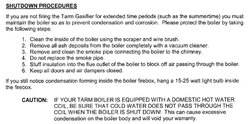When the ambient temperature has been cool, and then it shifts back to warm, the water jacket is going to act like a condenser and water is going to form from the humid air passing across it. The more air passing across it, the more water will form. Limiting the amount of humid air passing across it will reduce the amount of water formed.
When the water jacket is warmer, and the air is cooler and dryer, the water will evaporate from it. It will requires less dry air to evaporate the water formed during the other phases.
Using a water displacing coating, after cleaning the surface as thoroughly as possible, should prevent most rust as the water will be pushed off the surface, out of the crevices, and then sealed.
A moisture collecting chemical drying agent will pull moisture from the air that manages to get into the firebox.
After cleaning the firebox completely, might turn the circulator on and let the oil burner heat the firebox to 180 degrees, then coat it.

When the water jacket is warmer, and the air is cooler and dryer, the water will evaporate from it. It will requires less dry air to evaporate the water formed during the other phases.
Using a water displacing coating, after cleaning the surface as thoroughly as possible, should prevent most rust as the water will be pushed off the surface, out of the crevices, and then sealed.
A moisture collecting chemical drying agent will pull moisture from the air that manages to get into the firebox.
After cleaning the firebox completely, might turn the circulator on and let the oil burner heat the firebox to 180 degrees, then coat it.

SWF said:LeonMSPT said:With the vast fluctuations in temperature and humidity here in Maine during the spring, summer, and fall... I think allowing "some" airflow through the firebox is a good idea. However, completely open doesn't sound great either... coating it, adding a drying agent like calcium whatever the heck it is, or a light bulb/goldenrod, and slight airflow would be the right thing...
SWF said:I may have missed it in other replies, or it could just be obvious, but keeping the combustion doors open or just removing them altogether for the off-season is also important. This will help prevent moisture from building up during the off-season. I think just giving the entire boiler a good internal cleaning and then removing the doors will prevent the majority of corrosion.
Don't understand how you think that allowing some(?) airflow is better than completely open access. The chambers are not airtight, so you can't prevent any moisture in the air from getting in, but by having the chambers open you do prevent moisture from building up. Just as an FYI, the EKO manual specifies that the doors should be left open in the off-season to minimize corrosion. One further point is that you have to be careful applying coatings that you don't trap moisture under the coating, which would actually cause more corrosion than if there was no coating at all. A lightbulb or small fan is a good idea as long as you don't mind the electricity consumption.


 "A man's got to do what a man's got to do."
"A man's got to do what a man's got to do." 